
Megophryidae, commonly known as goose frogs, is a large family of frogs native to the warm southeast of Asia, from the Himalayan foothills eastwards, south to Indonesia and the Greater Sunda Islands in Maritime Southeast Asia, and extending to the Philippines. Fossil remains are also known from North America. As of 2014 it encompasses 246 species of frogs divided between five genera. For lack of a better vernacular name, they are commonly called megophryids.

The southern frogs form the Leptodactylidae, a name that comes from Greek meaning a bird or other animal having slender toes. They are a diverse family of frogs that most likely diverged from other hyloids during the Cretaceous. The family has undergone major taxonomic revisions in recent years, including the reclassification of the former subfamily Eleutherodactylinae into its own family the Eleutherodactylidae; the Leptodactylidae now number 206 species in 15 genera distributed throughout Mexico, the Caribbean, and Central and South America. The family includes terrestrial, burrowing, aquatic, and arboreal members, inhabiting a wide range of habitats.

Conraua, known as slippery frogs or giant frogs is a genus of large frogs from sub-Saharan Africa. Conraua is the only genus in the family Conrauidae. Alternatively, it may be placed in the family Petropedetidae.
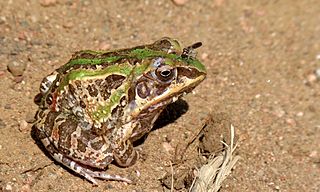
Hildebrandtia is a genus of frogs in the family Ptychadenidae. They are distributed in tropical and subtropical Sub-Saharan Africa. The common name of this genus is Hildebrandt's burrowing frogs or ornate frogs. The genus name honours Johann Maria Hildebrandt, a German botanist and explorer.
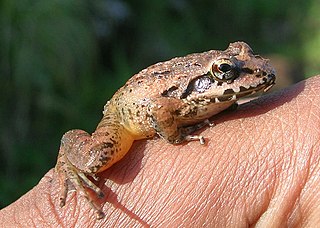
Indirana is a genus of frogs in the family Ranixalidae. These frogs are endemic to the Western Ghats of India. They are sometimes known under the common name Indian frogs, whereas members of their parent family are named "leaping frogs".
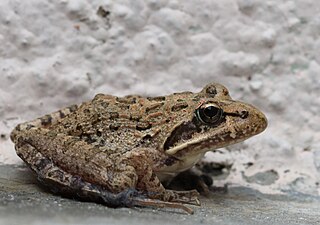
Strongylopus is a genus of pyxicephalid frogs native to Africa. They are found in the area from southwestern South Africa and Namibia to southern Tanzania. Their common name is stream frogs.
Altiphrynoides is a genus of toads, commonly referred to as Ethiopian toads. They are restricted to highlands of south-central Ethiopia in the Arussi, Bale and Sidamo Provinces. Both species are threatened by habitat loss. They were formerly included in Nectophrynoides, but lack the unusual reproductive mode of those species. Conversely, some authorities treat Altiphrynoides as a monotypic genus for A. malcolmi, placing A. osgoodi in another monotypic genus, Spinophrynoides.

Phrynobatrachus is a genus of Sub-Saharan frogs that form the monogeneric family Phrynobatrachidae. Their common name is puddle frogs, dwarf puddle frogs, African puddle frogs, or African river frogs. The common name, puddle frog, refers to the fact that many species breed in temporary waterbodies such as puddles.

The Petropedetidae are a family of frogs containing three genera and 12 species. They are found in sub-Saharan tropical Africa and are sometimes known under common name African torrent frogs.
Ptychadena submascareniensis is a species of frog in the family Ptychadenidae. This West African frog is found on the Nimba Range of Ivory Coast, Guinea, and Liberia, and on the Loma Mountains of Sierra Leone.
Ptychadena tournieri is a species of frog in the family Ptychadenidae. It is a widespread species in West Africa and found in Senegal, Gambia, Guinea-Bissau, Guinea, Sierra Leone, Liberia, and Ivory Coast, as well as in Togo and Benin; it is assumed to occur in Ghana and southeastern Burkina Faso, although it has not been recorded there. On the other hand, some records may refer to other species; the Amphibian Species of the World excludes Gambia and Togo from the distribution. Common names Liberia grassland frog and Tournier's rocket frog are sometimes used.
Ptychadena trinodis is a species of frog in the family Ptychadenidae. Its common name is Dakar grassland frog. It is widely distributed in West and Middle Africa, and following the International Union for Conservation of Nature (IUCN), occurs in Benin, Cameroon, Central African Republic, Chad, Democratic Republic of the Congo, Gambia, Ghana, Guinea, Ivory Coast, Mali, Mauritania, Nigeria, Senegal, and Togo. Further, records are missing from Guinea-Bissau, Burkina Faso, Niger, South Sudan, and Sudan, but it is presumed to be present in these countries too.

Nyctibatrachidae is a small family of frogs found in the Western Ghats of India and in Sri Lanka. Their common name is robust frogs. Recognition of Nyctibatrachidae as a family is fairly recent. These frogs were earlier on placed in the broadly defined family Ranidae, most recently divided in three subfamilies, Lankanectinae, Nyctibatrachinae, and Astrobatrachinae.
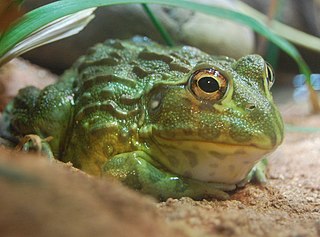
The Pyxicephalidae are a family of frogs found in sub-Saharan Africa.

The frog family Dicroglossidae occurs in tropical and subtropical regions of Asia and Africa, with most genera and species being found in Asia. The common name of the family is fork-tongued frogs.
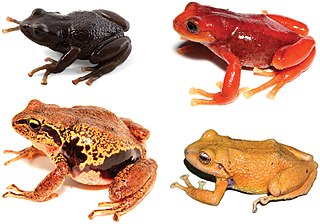
The Craugastoridae, or fleshbelly frogs, are a family of New World direct-developing frogs. As delineated here, following the Amphibian Species of the World, it is a large family containing 857 species. They are found from the southern United States southwards to Central and South America.

The Ranoidea are a superfamily of frogs in the order Anura. Members of this superfamily are characterised by having the pectoral girdle fused into a single complex unit, having no ribs, and using an axillary grip during amplexus. The larvae have a single spiracle on the left side and complex mouthparts, or in some species, undergo direct development. The taxonomy of these families has been under heavy debate for many years. In recent studies, molecular data has been used to better identify the phylogentic relationships of these frogs, rearranging and introducing new subfamilies to better distinguish between large groups of frogs.

Gracixalus is a genus of shrub frogs from south-eastern Asia.

Ranixalidae is a family of frogs commonly known as the leaping frogs or Indian frogs. They are endemic to central and southern India.















